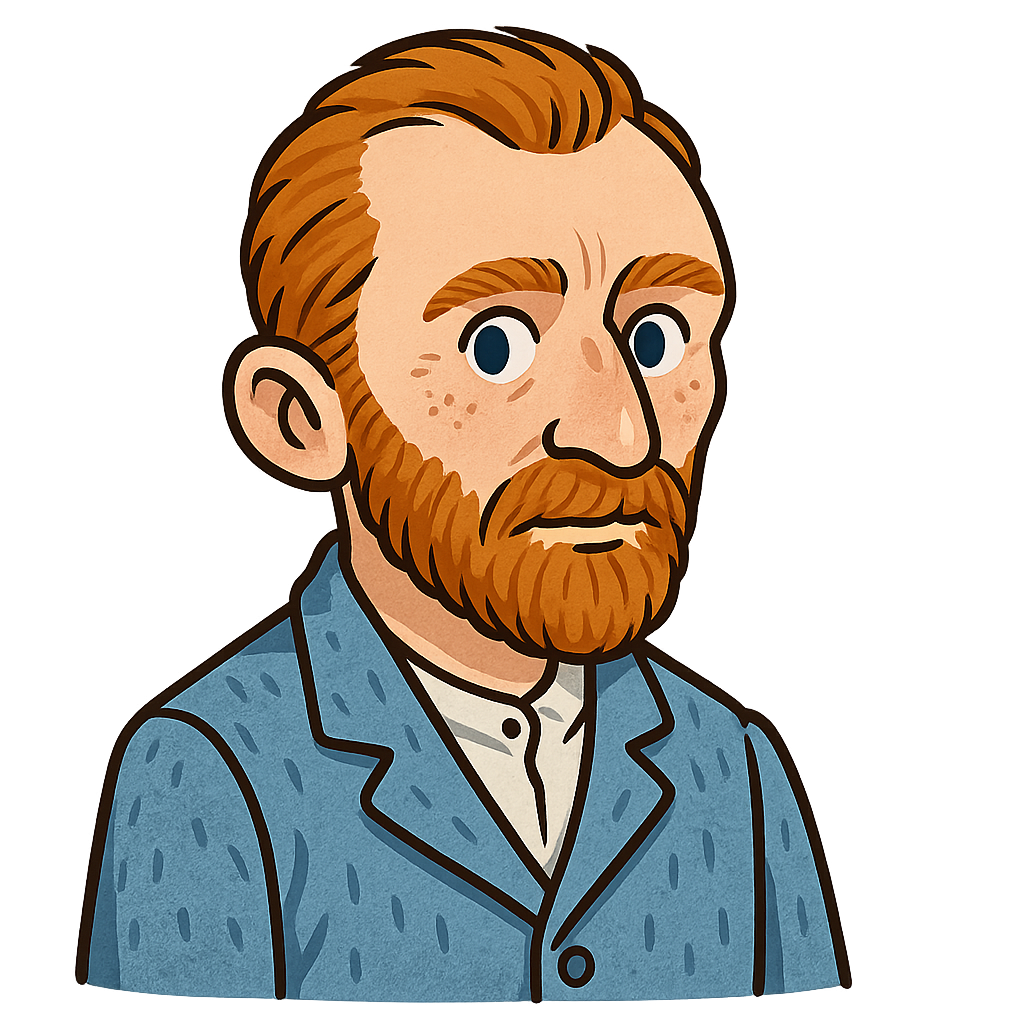Vincent van Gogh
Hello. My name is Vincent van Gogh, and I am a painter who loved to fill my canvases with color and light. My story begins in a country called the Netherlands, where I was born in 1853. I grew up in a big family with five brothers and sisters, but my closest friend was my younger brother, Theo. He understood me better than anyone. As a boy, my favorite thing to do was wander through the green fields and woods near my home. I wasn't just walking; I was watching. I would stare at the little bugs crawling on a leaf, the way the sunlight hit a flower, and the tired faces of the farmers working the land. I would pull out my sketchbook and draw everything I saw. I didn't know it then, but these quiet moments of drawing nature were the very first steps of my journey to becoming an artist.
Becoming a painter wasn't a straight path for me. When I was a young man, I tried many different jobs, trying to figure out where I belonged. I worked in my uncle's art gallery, where I was surrounded by beautiful paintings every day. Later, I worked as a teacher in England. I always felt a strong need to help people, so for a time, I lived in a poor mining village in Belgium. I wanted to comfort the miners, who had such difficult and dangerous lives. I spent my time with them, sketching their weary faces and the dark, gloomy world they lived in. It was there, while drawing their struggles, that a powerful feeling grew inside me. I realized that the best way I could share the stories of people and the beauty of the world was through my art. At the age of 27, I decided to become an artist.
My brother, Theo, always believed in me. In 1886, he invited me to come live with him in Paris, France. Paris was like a whole new world! It was a bustling, exciting city filled with artists who were trying new things. They weren't using the dark, serious colors I was used to. Instead, their paintings exploded with light and bright, cheerful colors. They taught me to see the world differently. I met painters who would dab little dots of pure color onto the canvas to create a shimmering effect. Inspired, I threw away my dark browns and grays and began to use brilliant blues, sunny yellows, and fiery reds. My own art began to feel alive and full of energy, just like the city around me.
Even with all the excitement of Paris, I longed for something more. I dreamed of a place where the sun was even brighter and the colors were even more intense. In 1888, I moved to a small, sunny town in the south of France called Arles. The sunshine there was magical! It was a brilliant, golden light that made everything glow. I felt so inspired that I painted almost every single day. I painted the fields of yellow wheat, the bright sunflowers standing tall in a vase, and even my own simple bedroom with its blue walls and yellow bed. It was a very happy time for my art. But I must tell you, I felt things very deeply. Sometimes my happiness was so big it felt like it would burst, but other times, my sadness was just as powerful and could feel very overwhelming. This made life difficult for me and sometimes for my friends, too.
There were times when my strong feelings became too much to handle, and I became unwell. In 1889, I went to stay at a hospital in a town called Saint-Rémy to rest and get better. Even during this sad and difficult period, I found comfort in my art. I had a room with a window that looked out over the countryside. At night, I would stare at the sky. It wasn't just a dark blanket with dots of light; to me, it was alive. I saw the stars burning brightly and the moon glowing with energy. I saw the sky swirling with wind and emotion. I took out my canvases and painted what I saw and felt, using thick, swirling brushstrokes of deep blues and bright yellows. This painting became one of my most famous works, 'The Starry Night'.
I spent my last few months in a village near Paris, and I never stopped painting. I painted the wheat fields under troubled skies and the gardens full of flowers. During my entire life, I only ever sold one single painting. It was easy to feel like a failure. But I kept painting because I had to share how I saw the world. My life ended in 1890, but my journey wasn't over. Looking back, I see that my real success wasn't about selling paintings. It was about pouring my heart onto the canvas and showing the world its beauty and its pain. Today, my paintings with their thick paint and bright colors are loved by people all over the world, and I hope they bring you a little bit of joy.
Reading Comprehension Questions
Click to see answer
